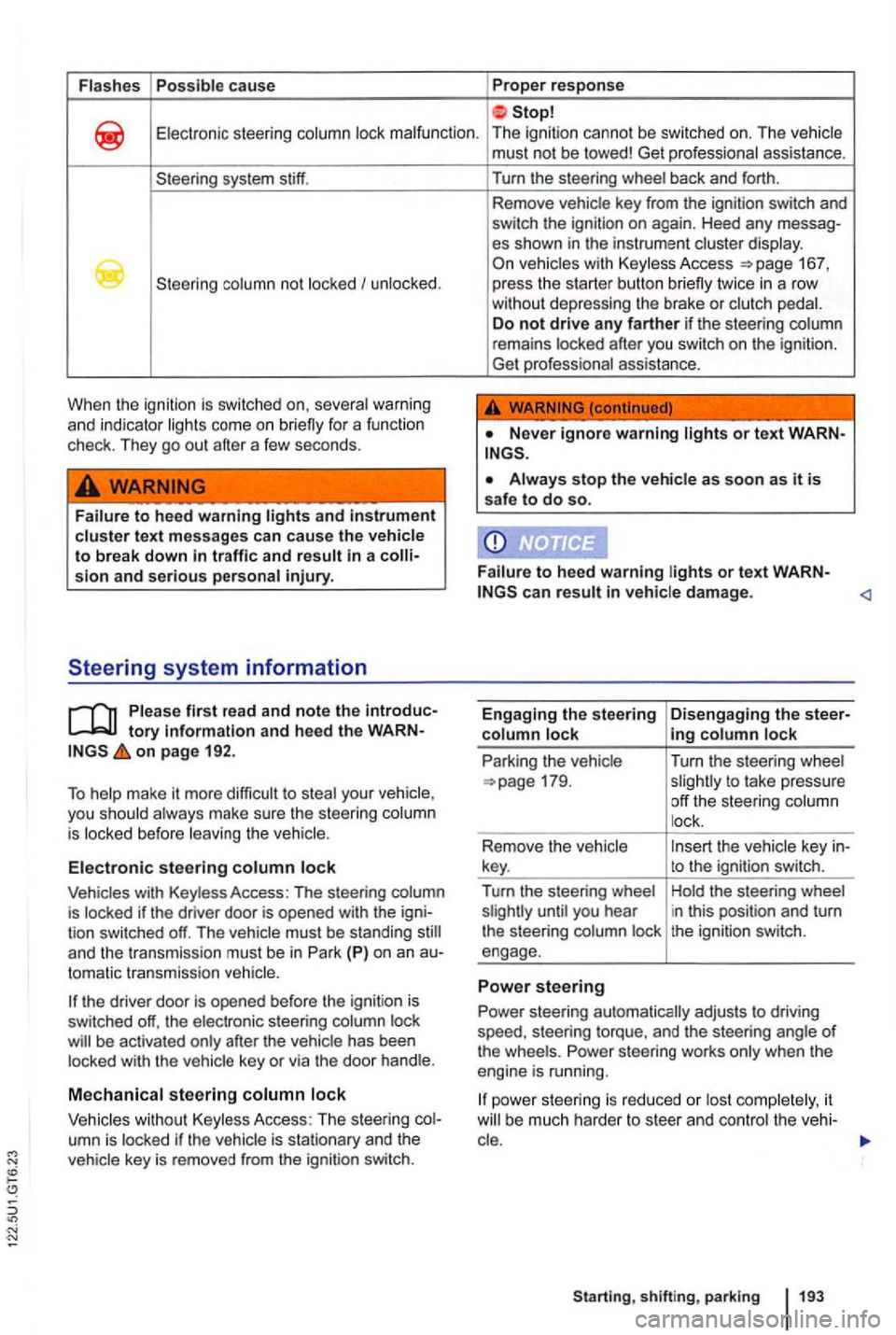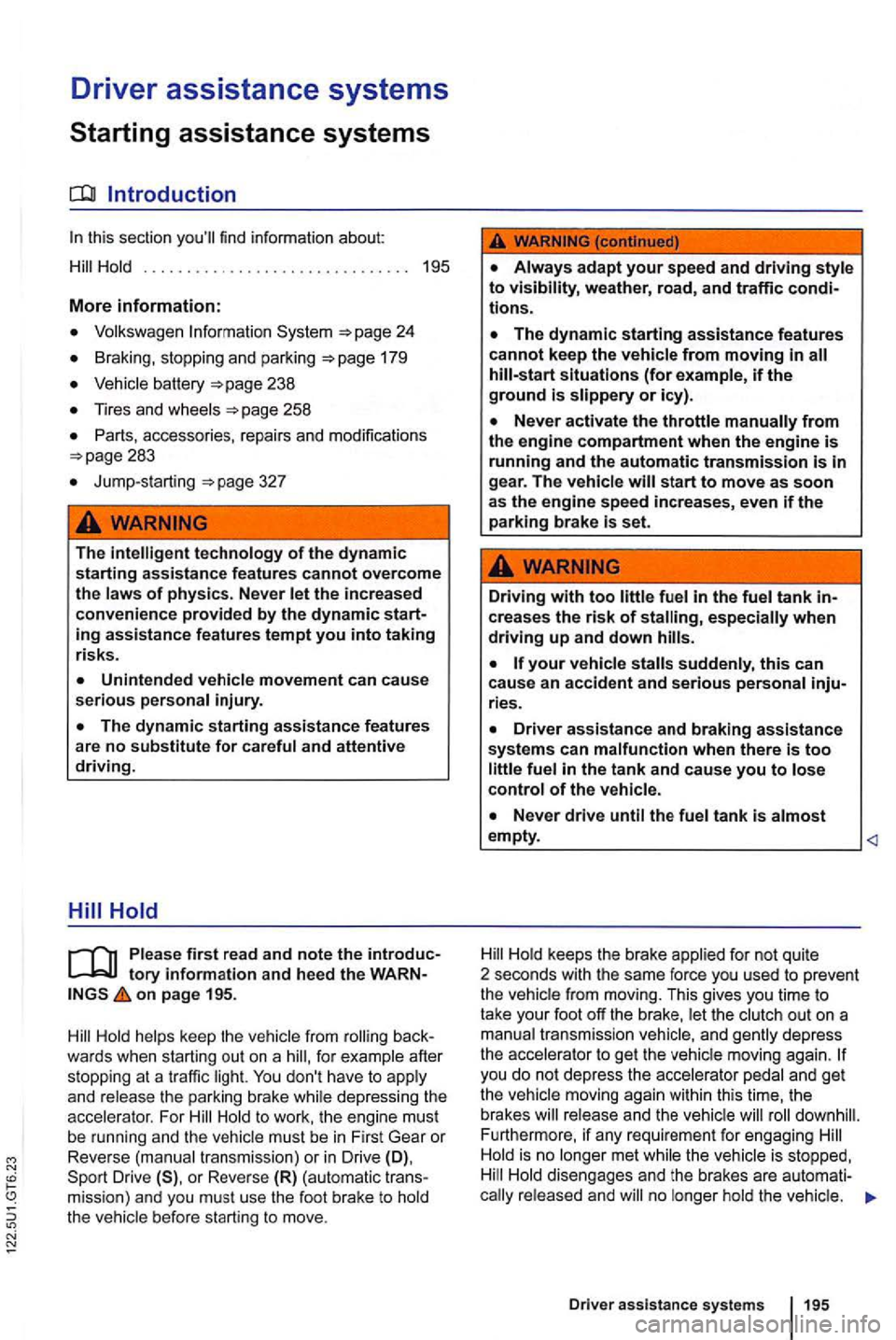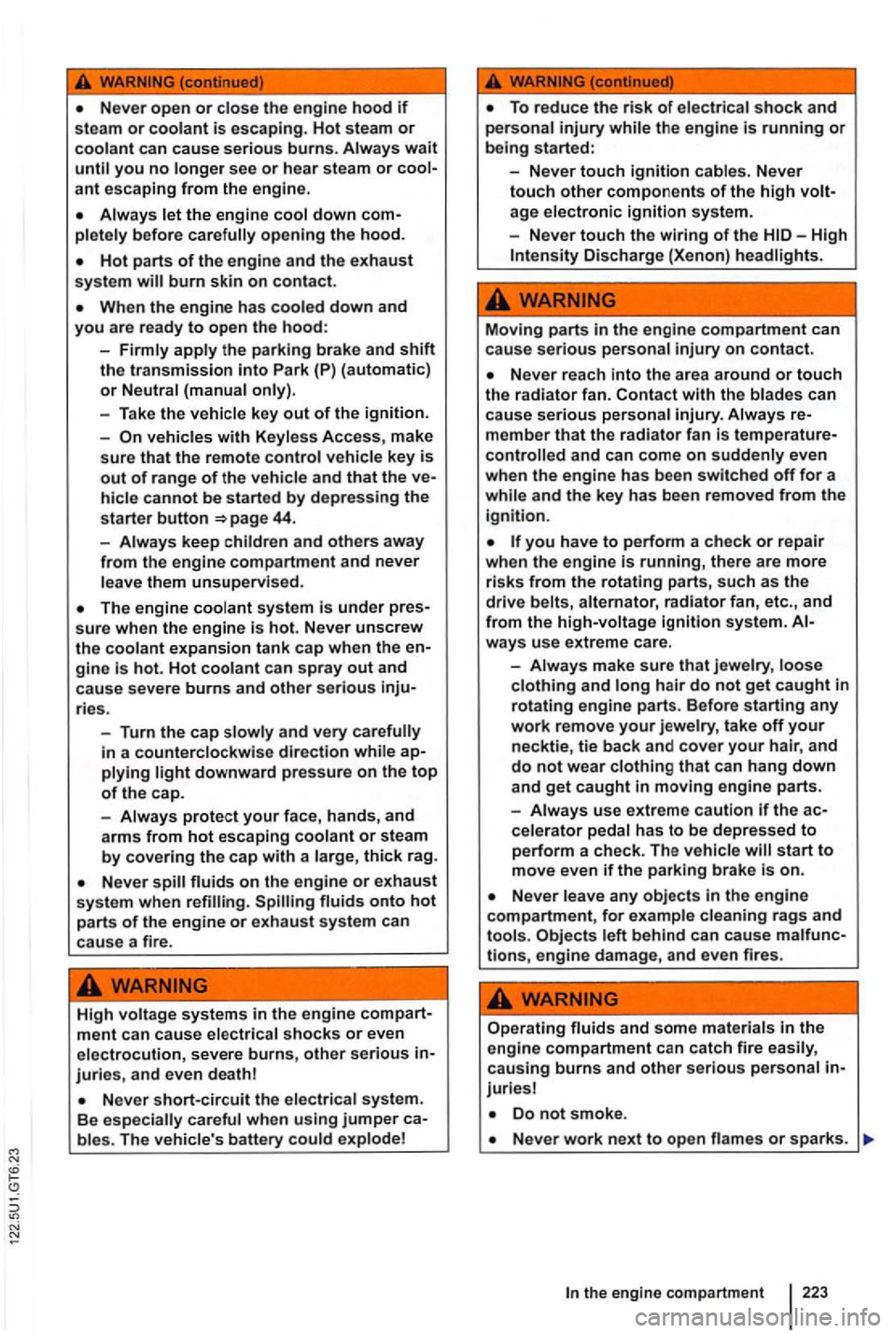Page 292 of 516

Flashes Possible ca use Proper response
Electronic steering column lock malfunction . The ignition cannot be switched on. The vehicle
system stiff.
column not locked I unlocked .
When the
ignition is switched severa l warni ng
a n d indicator lights come on briefly for a function
check . T hey go out after a few seconds.
Failure to heed warning lights and instrument cluster text messages can ca use the vehicle to break down sion and serious personal injury.
tory Information and heed the on page 192.
To
tomatic transmiss ion vehicle.
press the starter button briefly twice in a row
without depressing the brake or clutch pedal.
D o
not drive any farther if the steering column
remains locked after you switch on the ignition.
Get professional assistance.
Always stop the vehicle as soon as it is safe to do so.
F a
ilure to heed warning lights or text can resu lt vehicle damage .
Engaging the steering
co lumn lock
Park ing the vehicle
ing column lock
Turn the steering wheel
slightly to take pressure
off the steering column
l ock .
to the ignition switch.
Hold the steer ing wheel
i n this position and turn
the ignition switch.
Power steering automatically adjusts to driving
speed , steering torque, and the steering angle
of the wheels . Power steering works only when the
engine is running .
it
Sta rting, sh ift ing , park ing
Page 294 of 516

Driver assistance systems
Starting assistance systems
Volksw age n Informatio n pag e 24
pa ge 179
Vehicle batt ery
p age 2 58
Jump-s ta rting page 327
The
on p age 195 .
fo r examp le afte r
s topping at a traffic light. don't have to app ly
an d r elease th e park ing brake whil e depress ing the
accele ra tor . For
The dynam ic sta rting assistance feature s
cannot keep the vehicle from moving in all hill-start situations (for example, if the ground is slippery or icy).
Driving with too little fuel in the fuel tank in-
c rea se s th e risk of especially when driving up and down hills.
H old keeps th e bra ke a ppl ied for not quit e
2 seconds with the same force you u sed t o p reve nt the veh ic le f rom mov ing. This gives you time to
t ake your foot off the brake , let the clu tch out on a manual transm issio n veh ic le, a n d gently depress
the accele ra tor to get the veh icle m ovi ng agai n.
F urther more, if any requi remen t for engagi ng
Ho ld disengages and the brakes are automati no longer ho ld th e vehic le.
Driver ass is tance systems 195
Page 295 of 516
conditions are
3. A manual transm iss ion vehic le must be in 1st
gear (1 ) i f headed up a or in Reverse (R ) if backing up a you must hold the clut ch down
and the foot brake must be depressed to keep
the vehic
le from moving.
' Rel
ease
the brake as you let the clutch out and gently depress the accelerator.
any requi rement lis ted in the tab le above is
no longer met (see 196 , ed automatically when the following conditions are all met at the same time.).
gine malfunctions .
Automatic transmission vehicles: the mission i s in Neutral (N).
Automatic transmission vehicles:
and
the foot brake must be depressed to keep the
vehic le from moving .
Relea
se the brake as you gently depress the accelerator.
cle in start situations (for example, if the surface icy or slippery).
down the
Page 302 of 516
to heed warning and instrument text messages can cause the to break down traffic and sion and serious
or text
stop the as soon as it is
safe to do so.
or text can damage .
the ignition is switched on, an acous tic warning sounds when tir e pressure is tected. a system malfunc tion is detected , no
aco ust ic warn ing sounds .
Driving fo r a lon ge r period of tim e o n roug h roa ds or w ith a dynamic and sporty s tyle can
m ake th e system te mpora rily unavai lable .
Th e in dicato r light
fu nc tio n, b ut
Tire Pressure Monitoring
the
on
page
Your Tire Pressure Monitor
ing
4 tires
Brake
tires . The
tread circumference
of a tire can
change :
one side of the
than the other .
than the other (such as when towing a
has been
mounted .
a
a tire was changed.
the tire pressure was changed , or
were rotated or
was not reset.
warnings be
cause snow chains increase tire cir-
cumference.
Dri ver assistance syste m s
Page 316 of 516
Screw the cap neck you hear it
you hear it shut. The must be with the vehibody.
WARNING
burns, and other severe injuries.
stop once the pump noz
from
may the environment.
on
________
on page 214.
The engine compartment of any motor
you
know how to carry out the job,
have the correct information and the
proper and
are wi th the necessary safety precau
tions
you are uncertain in any way, have the work done by an authorized Serious injury may from pe rf ormed work. Make
s ur e that you check the The best thing is to check them every time you
129
227
Brake fluid 179
Tire pressu re
beams and high beams
-
- Brake
regardin g changing
At the gas station 217
Page 321 of 516

Care,
this sect ion
know how to carry out the
have the correc t technical information and the
proper too ls and supplies, and
are fami liar with the necessary safety precau
t ions
you are uncertain in any
Fa cility. from improperly per
formed work.
More
Exterior views
Windshie ld wipe r and was he r 129
S tart ing and stoppi ng t he engi ne
Brake fluid 179
Vehicle battery
E ngine oil 227
Engin e coolant 233
Parts, accesso ries, repairs and modifications 283
Unintend ed vehicle movement during maintenanc e work can ca use serious personal injuries.
Care , cleaning, maintenance
Never work under the vehicle unless you have safely secured the vehicle from moving. you mus t work under the vehicle with the
wheels on the g round , alway s make sure that the vehicle is on level ground, that
Th e engine compartment of any motor vehicle is a potent ially dangerous area and can cause serious personal injury.
Always use extreme caution when doing any work
Never p erform any work in the engine compartment unless you know exactly how to carry out the job and have the correct tec hnical information and the correct tools .
you are uncertain about what to do, have the work performed by an authorized
Volk swagen dealer, an authorized Volksw a
ge n Service Facility, or another qualified workshop. Serio us persona l injury may result from improperly performed work.
Page 322 of 516

Never open or close the engine hood if To reduce th e risk of electrica l shock and steam or coolant is escaping. Hot steam or personal injury
-Never touch ignition cables. Never ant escaping from the engine. touch other components of the high
Always the eng ine down com-age electronic ignition syste m .
opening the hood.
-Never touch the wiring of the Discharge (Xenon) headlights.
system burn skin on contact.
you are read y to open the hood: Moving parts in th e engine compartment can
- Firm ly apply the parking brake a nd shift cause serious personal injury on contact. the transmission into Park (P) (automatic)
vehicles with Keyless Access, make member that the radiator fan is temperature-
s
ure that the remote contro l vehicle key is controlled and can come on sudden ly even
out of range of th e vehicle and that the ve- when the engine
has been switched off for a
hicl e cannot be started by depres sing the 44. ignition.
-
Always keep children and others away you have to perform a check or repair from the engine compartment and never when the engine is runn ing, there are more leave them unsupervised. risks from the rotating parts, such as the
hair do not get caught in
ries. rotating engine
parts. B efore starting an y
- Turn
the cap
fluids onto hot parts of the engine o r exhaust system can
cause a fire. -
Always use
extreme caution if the ac-
ce lerato r pedal has to be depressed to perform a check. The vehicle will start to move even if the parking brake i s on.
Never leave any objects in the engine compartment, for examp le cleaning rags and tools. Objects left b ehind can cause malfunc-lions, engine damage, and even fires.
High voltage sy stems in the engine com part-ment can ca use electrica l shocks or even
electrocution, severe burns, other serious in-juries, and eve n deathl
Neve r short-circuit the electrica l syste m .
B e especially ca reful when using jumper ca-
Operating fluids and some materials in the engi ne compartment can catch fire easily, causing burns an d other serious personal in-juries
Do not smoke .
b les. The
vehicle 's battery could exp lode! Never work next to open flames or sparks .
223
Page 324 of 516
Getting ready to work in the engine compartment
information and heed the on page 222.
steps in the order in whic h they are
Park the vehic le in a safe place on a firm , su rface .
the brake pedal down
the par king brake to help preve nt the vehicle fr om moving 179 .
S hift th e t ra nsmiss ion
P ark (P) (automatic) or Neu tr al (manual page 171 .
Stop th e e ng in e a nd re m ove th e key f
rom th e ig nit ion sw itch 165 .
Le t the engin e down suffi cie ntly .
K eep children and others away from
the .
Make sure the ve hicle can not move unexpecte dly .
Disregarding the safety-rela ted checklist may re sult serious accept ed safety practices and use __ m_o_ n_s_e_n_s_e_. ____________________
Opening and closing the engine compartment
Fig . 1 26 engi ne hood release lever.
on page 222. Fig
. 1
27 Above the rad iator Outside engine
hood release .